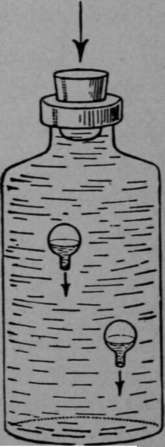Experiment 9. Balloon Races
Description
This section is from the book "Experimental Glass Blowing For Boys", by Carleton J. Lynde. Also available from Amazon: Experimental Glass Blowing for Boys.
Experiment 9. Balloon Races
Make another water balloon. Put the two balloons together in the bottle filled to overflowing with water.
Insert the stopper and press down hard. Do the balloons sink (Fig. 15), and does one sink more quickly than the other?
Release the stopper. Do the balloons rise, and does one rise more quickly than the other?
The most buoyant balloon sinks last and rises first.

A Balloon Race
You boys who have the Gilbert set on "Hydraulic and Pneumatic Engineering" will know the "why" of the last three experiments. Any body floats in water if it is lighter than an equal volume of water, and it sinks if it is heavier than an equaj volume of water. Water is practically incompressible but air is very compressible: thus when you press down on the stopper, you force water into the balloon and compress the air in it; when you release the stopper, the compressed air in the balloon expands and drives the water out. When the weight of the balloon and the weight of the water in it are together greater than the weight of water displaced by the balloon, the balloon sinks; when they are less, it rises.
Continue to:
- prev: Experiment 7. How To Make Water Balloons
- Table of Contents
- next: Experiment 10. Fun With Thin Tubes
